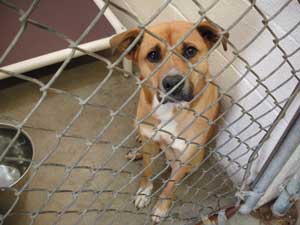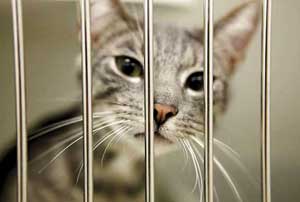 According to Petfinder there were over 8 million pets that entered into shelters across the nation in 2005, and approximately 5 million of those pets were adopted or returned to the owners (although returns account for about 2% of adoptions). We know what happened to the other 3 million; they were euthanized. That sounds horrible, and is often the main motivating factor for people to continue adopting pets from local shelters. The cold hard facts are tough, but we have come a long way since the height of euthanasia in the 1970’s. The average intake and kill rate for the US during the 70’s were over 17 million each year. That is when things started to change. So what has made the difference these last 30 years, and how can we get the numbers even lower? According to Petfinder there were over 8 million pets that entered into shelters across the nation in 2005, and approximately 5 million of those pets were adopted or returned to the owners (although returns account for about 2% of adoptions). We know what happened to the other 3 million; they were euthanized. That sounds horrible, and is often the main motivating factor for people to continue adopting pets from local shelters. The cold hard facts are tough, but we have come a long way since the height of euthanasia in the 1970’s. The average intake and kill rate for the US during the 70’s were over 17 million each year. That is when things started to change. So what has made the difference these last 30 years, and how can we get the numbers even lower?
What has made the difference in going from 17 million to 3 million euthanized each year? The answer is simple, awareness. There have been multiple campaigns through the Humane Society, ASPCA, and local shelters to adopt from shelters and spay and neuter your pets. There is also the effort made to reduce and even eliminate puppy mills in many states as well as stronger laws against back yard mass breeding and stronger leash laws to prevent loose animals turning into homeless animals. Once you make people aware, attach some famous names to the effort and play the commercials for decades on end you can drastically change how people find pets, maintain them and ensure they do not breed. The other factor that has had a large effect on the amount of pets euthanized each year is that more homes than ever now have pets. In 2005 there were roughly 7.1 million homes that have either a cat or a dog, this 20% increase from 30 years ago. And there are more homes with both cats and dogs, about an 8% increase. Even more so there are more homes with multiple cats or dogs too! It’s no wonder that pets are big business.
 There are still some very unique problems facing our current shelters today. One of the biggest problems is long term adoptees. Dogs are staying in shelters longer and longer, and many of the shelters were built to house many dogs for a short term so the facilities are not adequate for long term residents. Many of these dogs that are staying in these shelters are not getting the adequate attention they need. Dogs are social creatures even in their wild form of wolves. All the amazing breeds we have created have one thread in common, human devotion. They need us, and rely on us for just about everything so keeping them housed with little to no attention other than feeding and medical care has a huge impact on their mental health. Many shelters are no longer full of thousands of adoptable dogs, but rather have a smaller surplus of dogs that are not being adopted because of behavioral problems. They have been unsuccessful pets that have been surrendered so they need training. Housing them until the next family comes along is not enough. These dogs that need special care often benefit the most from fostering with a family. It gives them the opportunity to live in a home, and learn real life skills that will help them become a better adjusted part of a new family. Our local Humane Society is comprised entirely of foster families that take the dogs in from all over Grand County and help them get the real life skills they will need to get adopted. This type of intake structure is often the hardest to maintain for shelters as well, as placing each dog with a foster family until they are adopted requires many volunteer homes that are willing to take on a dog they may only have for a short time. The benefits for dogs in foster homes are tremendous and far outweight the difficulties that shelters face in finding good homes and volunteers that are willing to help homeless dogs. People in a sense have come a long way with awareness of homeless pets, in particular homeless dogs and there is a big change in the way we keep and house them. New shelters are being built with long term care in mind, and the way animals are being housed long term is getting better. There are still some very unique problems facing our current shelters today. One of the biggest problems is long term adoptees. Dogs are staying in shelters longer and longer, and many of the shelters were built to house many dogs for a short term so the facilities are not adequate for long term residents. Many of these dogs that are staying in these shelters are not getting the adequate attention they need. Dogs are social creatures even in their wild form of wolves. All the amazing breeds we have created have one thread in common, human devotion. They need us, and rely on us for just about everything so keeping them housed with little to no attention other than feeding and medical care has a huge impact on their mental health. Many shelters are no longer full of thousands of adoptable dogs, but rather have a smaller surplus of dogs that are not being adopted because of behavioral problems. They have been unsuccessful pets that have been surrendered so they need training. Housing them until the next family comes along is not enough. These dogs that need special care often benefit the most from fostering with a family. It gives them the opportunity to live in a home, and learn real life skills that will help them become a better adjusted part of a new family. Our local Humane Society is comprised entirely of foster families that take the dogs in from all over Grand County and help them get the real life skills they will need to get adopted. This type of intake structure is often the hardest to maintain for shelters as well, as placing each dog with a foster family until they are adopted requires many volunteer homes that are willing to take on a dog they may only have for a short time. The benefits for dogs in foster homes are tremendous and far outweight the difficulties that shelters face in finding good homes and volunteers that are willing to help homeless dogs. People in a sense have come a long way with awareness of homeless pets, in particular homeless dogs and there is a big change in the way we keep and house them. New shelters are being built with long term care in mind, and the way animals are being housed long term is getting better.
So how can we get that number of euthanized dogs down from 3 million annually? Well the answers lies with you, really you! According to Tufts University there are only 1.13 animal shelters per 100,000 people in the US. That means that any support you provide towards your local animal care has a huge impact. In the giving spirit you can donate money, time, expertise and it will make a big difference. What you can do at home is even more important. First, spay and neuter your pets. The cost of surgery is less than raising 1 offspring for a year!! And the average litter size is 6 puppies or kittens. Second, when you do decide to get a pet, take the decision seriously pets should be part of your family for life. Do your research and get expert help when it comes to picking a pet! Don’t be tempted by sad eyes, they all needs homes. Make sure you are a good match for each other so you can avoid returning the animal. Third, plan ahead for your pets. Have an emergency plan for your pets, and include care needs in your estate planning. Have crates, leashes and records ready to go in case of evacuation. Have directions about where your pets should go in case you pass before them. By planning ahead you can help reduce the amount of stress that comes with big changes and set your pet up to be well cared for in any type of bad situation and prevent them from ending up in the shelter. Last remember, giving is the best but remember giving a pet for the holidays can be a terrible idea. Just like the college you pick, or the car you choose, pets should be a well thought out decision. Save the surprises for something else. Happy Holidays to all of those pet lovers, and all the successful adoptees and some extra holiday love for those pets that are still looking for a home!
|